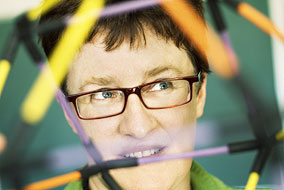
Susan Gerofsky's research showed that most people hate math word problems - photo by Martin Dee UBC Reports | Vol. 52 | No. 3 | Mar. 2, 2006
Two Camels Leave Cairo, One Heading West...
By Lorraine Chan
Two camels leave Cairo, one heading west at eight kilometres an hour, the other traveling north at six kilometres an hour...
Brainteasers like these have been circulating since the time of the ancients, but 4,500 years of history haven’t eradicated math word problems, nor people’s strong reactions to them, says Education Asst. Prof. Susan Gerofsky.
“Most of the people I spoke with during my research hate them,” says Gerofsky, a curriculum studies expert who’s exploring ways to improve math instruction.
Gerofsky says she’s intent on finding new teaching methods that will engage learners, including those with math “phobia.” Her future research includes developing software that will allow high school math students to use touch, musical sounds and whole-body movements to experience mathematical concepts.
“Many life choices are shut down to those who are fearful of math,” says Gerofsky. “I feel it’s vital we open our minds to what mathematics is and how we teach it. Besides, math gives us an incredible way to understand and appreciate the beauty of the world.”
Gerofsky comes to the discipline with a linguistics background and she advocates more awareness of language in math instruction. She traces the origins of math story problems in her 2004 book, A Man Left Albuquerque Heading East: Word Problems as Genre in Mathematics Education.
Gerofsky says these riddles date back to Sumerian and Babylonian cultures, which used them to teach mathematical methods. For millennia, they also flourished as “traveling salesmen jokes” along the Silk Road and other bustling routes of central Asia.
“Traders used these as icebreakers to socialize with people of another culture and to build trust through friendly problem-solving competition,” explains Gerofsky.
Centuries later, these word problems have infiltrated every textbook, from Grade 2 onward and through university in all undergraduate math and physics courses.
Given their ubiquity, Gerofsky says she’d like to see better use of these “odd little stories.”
“When you talk to really little kids and ask them, for example, how long it will take a snail to crawl out of a well at a certain rate, they’ll take your question to be a real life problem and want to solve it,” she says. “They’ll ask for extra information and offer up some really creative ideas, which may not have much to do with the mathematical ideas you intended them to learn.”
Gerofsky adds that by Grade 4, most children learn that these tales operate in their own strange universe and submit to them as a kind of drudgery.
“Students realize they’re math calculations dressed up as a story. It doesn’t matter whether it appears to be about two trains, a camel, birds or an emissary of the pope, their task is to strip the story down and solve the problem embedded there.”
For effective use of the genre, Gerofsky suggests that teachers stop presenting them as applications of math to real life situations.
David Lidstone, an instructor of mathematics and statistics at Langara College, concurs. Lidstone jazzes up math textbook offerings with his own word problems that give students a more immediate context.
“For problems pertaining to motion, which is common in calculus, I ask students to study two cars traveling along 12th Avenue and Kingsway,” says Lidstone. “And there’s a wealth of trigonometry problems in the angles on the face of a wristwatch.”
When teaching children, Gerofsky recommends that teachers admit upfront that these stories are symbolic. “Kids recognize that they’re not realistic at an extremely young age. If anything, word problems are closer to parables.”
However, Gerofsky insists the genre can still work. “Teachers can use the vivid imagery to help kids remember certain ideas and principles they can draw upon later.
“Sometimes these images are most memorable when the stories are nonsensical. For example, given a calculus problem that involves quadratic functions, it may help to say, ‘This is just like that story about shooting an arrow on the moon!’”
In general, Gerofsky advises math teachers to inject more “liberal arts” into math instruction to widen its appeal to different types of learners. She believes this is especially important given that many academic and career paths require math and physics.
“Math concepts are taught as if they exist in a void. They’re presented as fully formed, like a cold and distant crystal, as if this knowledge didn’t come through people living and struggling.”
Gerofsky would like to see the “messy parts of human history” included in math classrooms. “Wouldn’t it be interesting to say to students, here’s something that came from an ancient Egyptian papyrus manuscript or a Babylonian clay tablet? Give the history, explain that scribes were being taught this to help them feed the workers that built the pyramids.”
|
